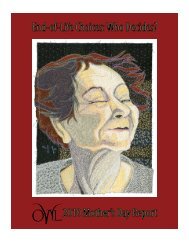elder abuse: a women's issue - OWL-National Older Women's League
elder abuse: a women's issue - OWL-National Older Women's League
elder abuse: a women's issue - OWL-National Older Women's League
You also want an ePaper? Increase the reach of your titles
YUMPU automatically turns print PDFs into web optimized ePapers that Google loves.
providing victim assistance and “safe-havens” for at-risk<strong>elder</strong>s; increasing prosecution; training social workersand others on signs, symptoms, and prevention; anddeveloping special programs to support underservedpopulations including rural, minority and Indianseniors. 15 This bill did not become law, but the efforts toenact the Elder Justice Act continue.Right now it is up to the states to create adequatelegislation that encompasses all of the necessarycomponents to combat <strong>elder</strong> <strong>abuse</strong> from every angle.As with child <strong>abuse</strong> and violence against women,what has proven to be somewhat successful is society’sresponse with a system of detection of <strong>abuse</strong> followed bymanagement of the problem. 16What is Elder Abuse?As defined by the <strong>National</strong> Center on Elder Abuse(NCEA), <strong>elder</strong> <strong>abuse</strong> is “knowingly, intentionally ornegligently causing harm or a serious risk of harm to avulnerable adult.” 17 Each state’s definition of <strong>elder</strong> <strong>abuse</strong>is slightly different, but the main types of <strong>abuse</strong> includedin the definition are: Physical Abuse, Sexual Abuse,Emotional Abuse, Neglect, Exploitation, Abandonment,and Self-Neglect, as defined below.• Physical Abuse - Inflicting or threatening toinflict physical pain or injury on a vulnerableadult, or depriving them of a basic need.• Sexual Abuse - Non-consensual sexual contactof any kind.• Emotional Abuse - Inflicting mental pain,anguish or distress on an <strong>elder</strong> person throughverbal or non-verbal acts.• Exploitation - The illegal taking, misuse orconcealment of funds or property or assets of avulnerable adult.• Abandonment - The desertion of a vulnerableadult by anyone who has assumed theresponsibility for care or custody of that person.• Self-Neglect - Behavior of the <strong>elder</strong>ly person thatthreatens his/her own health or safety. 18Currently there are 21 states reporting self-neglectin a separate category as its own independent form of<strong>abuse</strong>. 19 There are also two categories of <strong>elder</strong> <strong>abuse</strong>:Domestic Elder Abuse and Institutional Elder Abuse.Domestic Elder Abuse can refer to several differenttypes of <strong>abuse</strong>, but is generally perpetrated by someonethat has a special relationship with the <strong>elder</strong>ly person,and occurs in the home. Institutional Elder Abuserefers to <strong>abuse</strong> occurring in residential care facilitiessuch as nursing homes, foster homes, group homes, andassisted living communities. The persons perpetratingInstitutional Elder Abuse are those that generally havea legal or contractual obligation to care for the <strong>elder</strong>lyperson, such as the caregivers, staff or administrators ofthe institution. 20Domestic Elder AbuseIt is difficult to know how many of our <strong>elder</strong>lyare being <strong>abuse</strong>d in a domestic setting because ofthe nature of the problem. There is not a uniformdefinition addressing both <strong>abuse</strong> and neglect, and nocomprehensive, effective reporting system is solidly inplace. 21 In 1998 the Administration for Children andFamilies and the Administration on Aging collaboratedwith the <strong>National</strong> Center on Elder Abuse under acongressional mandate to produce the best study of <strong>elder</strong><strong>abuse</strong> in the U.S. This study was called the <strong>National</strong>Elder Abuse Incidence Study (NEAIS). 22 Findings inthe study revealed that in 1996, nearly half a millionpeople age 60 and over had experienced <strong>abuse</strong> or neglectin domestic settings. However, only 16% of these caseswere reported to Adult Protective Services agencies.This study also determined that <strong>elder</strong> <strong>abuse</strong> is harder todetect than child <strong>abuse</strong> because of the social isolationof the <strong>elder</strong>ly. 23 Oftentimes the <strong>elder</strong>ly are completelydependent on their <strong>abuse</strong>r for basic daily needs, andif they report the <strong>abuse</strong>, they feel that they would beunable to care for themselves or will have to be placed ina nursing home. 24 In this respect, the nature of domesticviolence against the <strong>elder</strong>ly is slightly different from thesituation of a battered woman. In domestic <strong>elder</strong> <strong>abuse</strong>,approximately 90% of <strong>abuse</strong>rs are related to the victim.Reporting to Adult Protective Services has been risingand between the years 1996-2004 the reported casesrose from 115,110 to 253,426. 25 Elderly victims havethe same reasons for not reporting <strong>abuse</strong> as other classesof victims. They may feel ashamed or embarrassed ofthe <strong>abuse</strong> and want to keep it a private matter. Withdomestic violence being talked about more openlyin younger generations, the door may open for <strong>elder</strong><strong>abuse</strong> to be discussed more freely as long as advocates8



